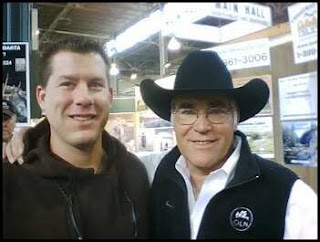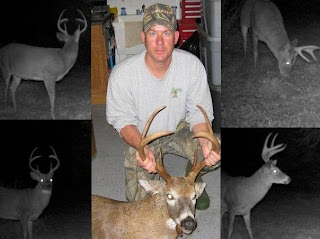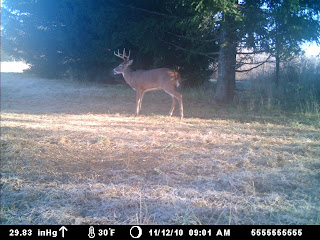TOUCHED BY LIGHTBY CHARLES J. ALSHEIMER
“And God said, ‘Let there be lights in the expanse of the sky to separate the day from the night, and let them serve as signs to mark seasons and days and years, and let them be lights in the expanse of the sky to give light on the earth.’ And it was so. God made two great lights – the greater light to govern the day and the lesser light to govern the night. He also made the stars. God set them in the expanse of the sky to give light on the earth, to govern the day and the night, and to separate light from darkness. And God saw that it was good. And there was evening, and there was morning – the fourth day.” (Genesis 1:14-19, NIV).
After practically living with nature for over half a century, I’m still in awe of the way God pieced our universe together. What a Creator! Everything He created is precise and perfect. Each natural phenomenon has a reason for existing. It’s truly amazing how the natural world influences every aspect of the whitetail’s life.
For the last eight years, Vermont wildlife biologist Wayne Laroche and I have been researching the influence the moon has on the timing of the whitetail rut in the North, specifically north of the 35th latitude. In its eighth year, the project is expected to run for fifteen years before being completed. Why so long, you ask? There are a number of reasons, but the primary factor is the fluctuation in the timing of what we refer to as the whitetail’s rutting moon, which is the second full moon after the autumnal equinox.
Those who have followed our work know that the timing of the rutting moon comes within a day or two of repeating itself every eleven years and reasonably close to repeating itself every three to four years. Consequently, it’s important to collect good data over an extended period of time in order to evaluate the moon’s impact on white-tailed deer rutting activity.
Genesis of the Work
Though we’ve been collecting data for the last eight years, our interest in this project was born over fifteen years ago.
Laroche is a respected fisheries biologist. He is also an avid whitetail hunter who spends the entire month of November in northern Maine chasing big woods bucks. He became interested in the moon’s influence on whitetails after researching the impact the moon has on Grouper fish in the Caribbean and the Gulf of Mexico. As he hunted the Maine woods every year, he noticed distinct fluctuations in whitetail activity patterns. After studying the yearly changes he began to wonder if the moon was affecting the way whitetails behaved during November, just as it had influenced the fish he had studied over the years.
My interest in lunar-related behavior began in the mid-1980s while hunting and photographing. Up until then I had bought into the research data that originated in the 1950s and 60s that said the peak breeding period for whitetails in my region of the North (42nd latitude) would be November 15-20 each year.
Over a ten-year period (1985-1995) I had the opportunity to photograph whitetails extensively on a large property in the Adirondack Mountains of New York. During this time I shot hundreds of rolls of film and kept detailed notes on deer behavior. Despite the deer population and the adult doe-to-antlered buck ratio remaining constant, the peak breeding period was seldom the same from year to year. Some years the breeding took place in early November, some years mid-November, and some years late November. It was obvious to me that something more than photoperiod, or shortening day length, was driving the timing of the rut’s seeking, chasing and breeding phases.
In the early 90s I became aware of work Laroche was doing that dealt with the relationship between the width of a whitetail’s track and its body size. To learn more, I interviewed him for a magazine article I was writing. We shared many things about ourselves and our love for whitetail hunting. During the course of our discussion we talked about the variations we were seeing in the timing of whitetail rutting behavior. I’ll never forget Wayne’s comment that he believed the moon was responsible for the fluctuations in deer activity that we were observing during November. After our conversation, we decided to see if the moon had anything to do with the timing of the whitetail rut.
The Hypothesis
As further background, I’ll offer the hypothesis for our research. At some point in autumn, the amount of daylight decreases enough to reset the whitetail’s reproductive clock, thus placing the breeding season in November, December and January in the Northern Hemisphere. Once the doe’s reproductive cycle is reset by a specific amount of daylight, her estrous cycle is ready to be cued by moonlight, which provides a bright light stimulus to the pineal gland several nights in a row each lunar month. Then, the rapid decrease in lunar brightness during the moon’s third quarter triggers hormonal production by the pineal gland. Physiological changes prompted by the pineal gland culminate in ovulation and estrous.
A northern doe’s estrogen level peaks around November 1st, as does a buck’s sperm count. With both sexes poised to breed, it stands to reason a mechanism must be in place if the doe is to enter estrous and be bred under the darker phases of the moon, which are the third through the first quarters. That mechanism in the North (north of about the 35th latitude) is usually the second full moon after the autumnal equinox, which we call the rutting moon.
What We Know at Halftime With each passing year, we’ve added more and more data collection devices to the research project. In the beginning, we monitored just six does. Now, we are collecting data for our research from nearly 100 does.
We also monitor air temperature, weather patterns and moonlight intensity throughout the fall. In addition, we have twelve Trail Timers to record deer activity throughout each day. Four of the timers are in my farm’s 35-acre high-fenced whitetail research facility and, at any one time, up to eight are positioned in other areas of our farm to monitor the wild, free-ranging deer population. The data, which is collected from October through December, is downloaded to our computers for analysis.
Unlike eight years ago, when no one was helping us, we now have several serious deer hunters and outfitters across North America (who are in the woods every day during the fall) keeping detailed journals to chronicle deer behavior in their regions of the country. This added information has allowed us to better understand what is happening in other parts of North America during October, November and December.
With well over 15,000 data points in our system, we’ve concluded that the second full moon after the autumnal equinox stimulates both buck and doe rutting activity. Past data suggest that when the rutting moon falls anywhere from late October to November 12th, the timing of the seeking, chasing and breeding phases of the rut is very predictable; we refer to this as a “classic rut.”
During the years when the rutting moon appears later (like 2002, when it occurred on November 19th), we’ve discovered that the timing of the rut’s seeking, chasing and breeding phases is just a little different. When the rutting moon arrives after November 13-14, we’ve found that the rut progresses more rapidly than when the rutting moon arrives earlier in the month.
Basically, the data show that when the rutting moon arrives late, the seeking begins three or four days before the full moon, just as we’ve always predicted. However, we’ve discovered that once the full moon occurs, the chasing is frenzied and the breeding kicks in within a day or two of the full moon’s appearance rather than a week after its arrival, as it does in years when the rutting moon appears in early November. The two years in our research project that illustrate this are 1997, when the rutting moon was November 14th, and 2002, when it arrived on November 19th.
In 1997 the data showed that the seeking and chasing phases of the rut didn’t happen until November 12-21. Breeding kicked in within a couple days of the rutting moon and ran through the end of the month.
The 2002 findings are nearly identical to 1997. In 2002, all but one reporting location indicated seeking and chasing peaked between November 16th and 22nd in the North. Breeding began around the 19th and 20th and peaked Thanksgiving week (November 24-28). There also was a fair amount of breeding still occurring the first few days of December. Looking to the future, I feel confident that the northern whitetail rut in 2005 and 2013 will be very similar. This prediction is based on the consistency of our data from 1997 and 2002. Rut Suppressors To varying degrees the project has revealed several factors that can effect the amount of deer activity observed during daylight hours.
Air temperature: Temperature readings and the Trail Timer data indicate that when the daytime temperature rises above 45 degrees during November, deer activity comes to an abrupt halt. With their heavy fur coat and inability to ventilate as humans do, deer simply cannot function in warm weather.
Sex ratio: Adult doe-to-antlered buck ratios greater than three to one also decrease deer activity during the three phases of the rut. This is primarily due to the fact that does are less active than bucks in November. With far more does than bucks in a population, every available buck is with a doe when the hot-to-trot rut arrives. On the other hand, in areas where the adult doe-to-antlered buck ratio is one-to-one or two-to-one, buck activity is greater because there are far fewer does to go around, resulting in competition between bucks for breedable does. As one might expect, we also see greater buck activity in populations that have more mature bucks in the herd.
Human pressure: The impact of human pressure is perhaps the “mother of all rut suppressors,” especially when daytime air temperatures rise above 45 degrees. Going into this project I had a feeling human presence in the deer woods would affect movement but I didn’t realize the impact would be so great. The Trail Timer data show that approximately 55 percent of deer movement occurs during daylight hours in areas where there is little or no human presence. In areas where there is moderate to heavy human activity in the form of hikers, birders, or hunters, only about 30 percent of deer movement takes place during daylight.
The Maine Lab
In order to get a better read on the moon’s influence on whitetail rutting behavior, Laroche and I have started to look more closely at how deer move in areas where humans, poor adult doe-to-antlered buck ratios, warm temperatures, and baiting have a minimal impact. There are few places in the United States where such conditions exist, but northern Maine is one of them.
The whitetails found in this region are not pressured by man, nature keeps the adult doe-to-antlered buck ratio at less than three to one, baiting is not allowed, and warm temperatures are not as common as they are in other regions of the country. What makes Maine so unique is that it has mature bucks in the population and snow is often present to tip off serious trackers as to what is going on in the deer world. So, with few rut suppressors present, the far northern portion of this vacationland is the ultimate place to study the moon’s effect on deer activity.
As mentioned earlier, Laroche spends the entire month of November in a northern Maine deer camp, living out of an 18′x52′ wall tent. His camp is limited to eight hunters at a time and each night Laroche debriefs every hunter, asking them to recall the number of scrapes and rubs observed, the number of deer sightings by sex, the types of behavior witnessed, and any other species of animals that were seen. This data is then analyzed and incorporated into our database. Laroche and his party cover a remote area of fifty to one hundred square miles on any given day.
Dick Bernier is a hunting legend in the state of Maine. He’s written two popular books on tracking white-tailed deer, and like Laroche, he and his father spend the entire month of November in the northern Maine bush tracking the biggest bucks they can find.
Interestingly, Bernier and his father realized long ago that there was a correlation between November’s full moon and the timing of the whitetail’s rut. When I began writing about the moon’s impact on the rut for Deer and Deer Hunting magazine, they contacted me to let me know that they concurred with the findings of our research. They also offered access to their records. So, at the end of each day, they log everything they observe into their journals and forward this information to Laroche and me. As one might expect, the observations of Laroche’s party and the Berniers have nearly mirrored each other.
Synopsis
Enlightening is one of the best words I know of to describe this research project. It amazes me that the relationship between the moon and the timing of the rut was not discovered long ago. We set out to run the project for fifteen years, and although we could probably wrap it up now because of the repeatable patterns we’ve observed and documented, we fully expect to continue for the remaining seven years. Simply put, our fascination with the project keeps our interest level high.
In 1999, I wrote Hunting Whitetails by the Moon. Chapter 16 of this book, “Predicting the Future,” was based on what I knew at the time. Because of what has been learned since then, I now know the predictions that were offered for 2005 and 2013 are a bit off. However, they easily can be adjusted by studying the following paragraphs.
As a quick recap, keep in mind that the seeking, chasing and breeding phases of the northern whitetail rut will occur as follows:
When the second full moon after the autumnal equinox falls between late October and November 12th, the seeking phase of the rut will start approximately three to four days before the full moon and run three to four days after it. The chasing phase will kick in a couple days after the full moon and be intense for about ten days following the full moon. The breeding phase will begin about seven days after the full moon and last about fourteen days thereafter if the herd is fine-tuned (meaning it has good nutrition, good habitat, a good sex ratio, and a well represented mature buck population). Note that the phases will overlap somewhat.
When the second full moon after the autumnal equinox occurs November 13th or later, the seeking phase will begin approximately three days before the full moon. However, the chasing phase will begin a little earlier than normal, and the breeding phase will occur from the full moon to fourteen days thereafter in fine-tuned herds. So, when the rutting moon appears late, the breeding phase takes place a little sooner than when it appears in early November. Not everyone has the flexibility to block out the whole month of November in order to have a ringside seat for the whitetail rut. The benefit of this research is the ability to let hunters and deer lovers know the optimal times to hunt and observe the whitetail rut.
Charles
5 hours, 44 minutes ago rosebudbill
19 hours, 10 minutes ago
rosebudbill
19 hours, 10 minutes agooutdoorguru
5 hours, 36 minutes agooutdoorguru
5 hours, 36 minutes agooutdoorguru
3 days, 2 hours agooutdoorguru
3 days agooutdoorguru
3 days, 2 hours ago fishnutz
3 days, 6 hours ago
fishnutz
3 days, 6 hours agoCharles
3 days, 10 hours agoCharles
4 days, 15 hours agooutdoorguru
4 days, 20 hours agoCharles
5 days, 6 hours agoCharles
6 days, 6 hours agooutdoorguru
1 week ago drop
1 week ago
drop
1 week ago

























